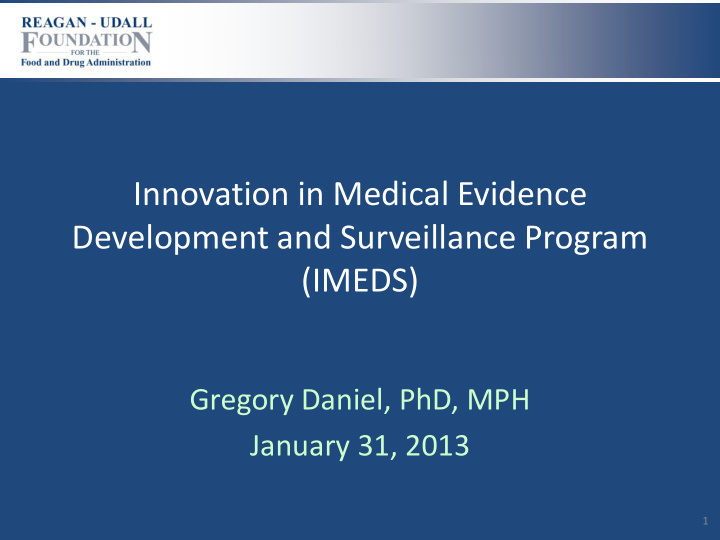



Innovation in Medical Evidence Development and Surveillance Program (IMEDS) Gregory Daniel, PhD, MPH January 31, 2013 1
Overview • High priority areas for Sentinel sustainability • Overview of Reagan-Udall Foundation • Introduction to IMEDS • IMEDS next steps 2
Background • Mini-Sentinel has made significant progress and is a useful tool for FDA • Ensuring long-term sustainability and maximum impact on public health are essential • High priority areas – Continued development of best methods for using electronic health data for safety assessments – Train new scientists and equip them with the knowledge and expertise to conduct safety assessments – Leverage the Sentinel tools to help answer other important questions about what works and doesn’t work in our health care system 3
Reagan-Udall Foundation for the FDA • The Reagan-Udall Foundation for the FDA is an independent 501(c)(3) not-for-profit organization created by Congress to: – Advance the mission of the FDA by furthering regulatory science and research with the ultimate goal of improving public health – Provide a unique opportunity to bring all stakeholders to the table to work on regulatory and development science – Serve as home for a public-private partnership to provide a sustainable pathway to support the methodological, training, and other needs of the Sentinel Initiative • On July 25, 2012 the RUF Board approved the IMEDS planning process to create a new program area to fill this need 4
Innovation in Medical Evidence Development and Surveillance Program (IMEDS) Mission: To support FDA’s mission by advancing the science and tools necessary to further post-market evidence generation for regulated medical products and to facilitate utilization of a robust secondary electronic healthcare data platform for generating such evidence Starting point… IMEDS-Methods: Facilitate methodological research aimed at improving the tools for conducting safety surveillance using automated healthcare data Soon to follow… IMEDS-Education: Train scientists in medical product safety surveillance using electronic health data IMEDS-Evaluation : Facilitate the use of Sentinel tools and capabilities to further understand the risks and benefits of medical products in the post-market setting 5
IMEDS Overview Progress to Date and Next Steps Progress to Date Next Steps Secured Accenture to support design Implement Communications Plan to inform key stakeholders about Assembled and convened IMEDS progress and to solicit input on Organizing Committee meetings to design IMEDS-Methods inform design of IMEDS-Methods Finalize IMEDS-Methods Charter Completed stakeholder interviews (with guidance from Organizing with stakeholders to supplement Committee and others) Organizing Committee perspectives Work with FNIH, FNIH Board, OMOP Began development of IMEDS- Executive Board, OMOP Investigators Methods Charter document detailing and Mini-Sentinel Planning Board to IMEDS-Methods Business Strategy, ensure alignment Operating Model and Governance Plan 6
IMEDS-Methods Organizing Committee Member Organization • Apple Tree Partners, Apple Tree Pharmaceuticals, TransCelerate Garry Neil, MD Biopharmaceuticals Inc. • Reagan-Udall Board Liaison Rachel Sherman, MD and • Food and Drug Administration Melissa Robb • Harvard Pilgrim Health Care Institute Richard Platt, MD, MSc • Mini-Sentinel: Principal Investigator • OMOP: Executive Board member • Janssen R&D Patrick Ryan, PhD • OMOP: Principal Investigator • Duke University Lesley Curtis, PhD • Mini-Sentinel: Leader, Data Core Alec Walker, MD, DrPH • World Health Information Science Consultants Claire Spettell, PhD • Aetna John Santa, MD • Consumer Reports • AARP Lee Rucker, MS • OMOP: Executive Board Member 7
Initial Focus: IMEDS-Methods Current Trends IMEDS-Methods Objectives: • Create a long-term methods research agenda Significant progress has that supports FDA safety activities been made on research methodology by both • Build an inclusive, educated community of OMOP and Sentinel methods researchers Electronic health data are constantly evolving; • Establish fully transparent governance to oversee research methods must implementation of research agenda evolve accordingly to properly utilize this data • Identify and cultivate best research methods Need exists for long-term, research agenda and • Establish a data environment needed for corresponding governance methods research structure to address Internal data laboratory methodological needs of • Sentinel Establish partnerships with Data Partners • 8
Questions or Comments? For more information: Troy W. McCall, Reagan-Udall Foundation troymccall@aol.com Greg Daniel, Brookings Institution gdaniel@brookings.edu 9
Recommend
More recommend